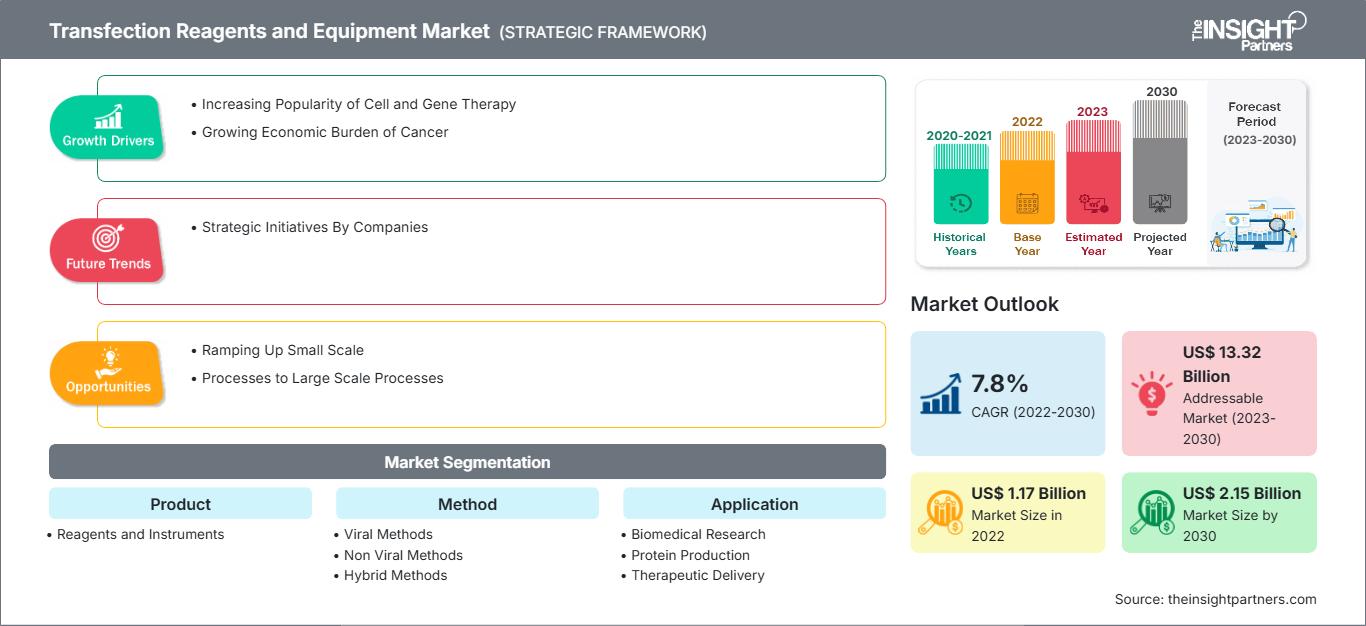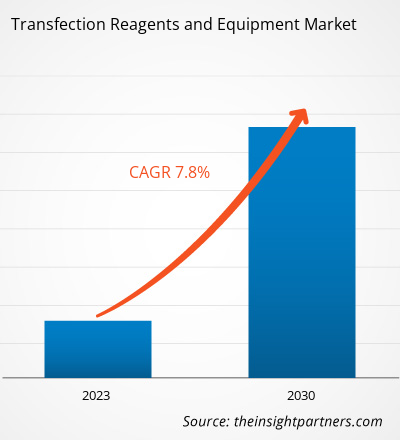[연구 보고서] 형질감염 시약 및 장비 시장은 2022년 11억 7,079만 달러에서 2030년 21억 4,503만 달러로 성장할 것으로 예상되며, 2022년부터 2030년까지 연평균 7.8%의 성장률을 기록할 것으로 예상됩니다.
시장 분석 및 분석가 의견:
형질감염 시약 및 장비 시장 규모의 확대는 만성 질환 증가와 세포 및 유전자 치료의 인기 급상승에 기인합니다. 형질감염은 화학적, 물리적, 생물학적 수단을 통해 이물질과 핵산을 세포 내로 전달하는 과정입니다. 형질감염 시약은 응용 유전자 치료 분야에서 수행되는 방대한 연구의 일환으로 수행되는 유전자 실험의 효능을 향상시키는 데 사용됩니다. 모든 형질감염 실험에서 화합물을 세포 내로 전달하는 방법은 신중하게 선택되어야 합니다. 바이러스 매개 형질감염은 상당한 효과를 입증했으며, 형질감염된 제품은 상당한 면역 반응을 유도할 수 있습니다. 그러나 이 기술에 바이러스를 사용함으로써 발생하는 부작용을 줄이기 위해 화학적 대안이 개발되었습니다.
성장 동력 및 과제:
세포 및 유전자 치료제 제조는 복잡한 공정이기 때문에 실행 및 모니터링이 매우 중요합니다. 생명공학의 발전으로 다양한 질환에 대한 맞춤형 치료법이 도입되었습니다. 세포 및 유전자 치료제는 주로 신경 질환, 암, 유전 질환과 같은 만성 질환 치료에 사용됩니다. 세포 및 유전자 치료제의 주요 장점은 표적 치료, 더 빠르고 효율적인 회복, 그리고 부작용 감소입니다. 세포 및 유전자 치료제는 미국 식품의약국(FDA) 승인 제품의 가용성 덕분에 전 세계적으로 널리 채택되고 있습니다. 예를 들어, FDA는 2022년에 Ferring Pharmaceuticals A/S가 제조한 아데노바이러스 ADSTILADRIN을 승인했습니다. 이 재조합 아데노바이러스(rAd-IFNa/Syn3)는 특정 유형의 방광암을 앓고 있는 환자를 치료하기 위해 인간 인터페론 알파-2b cDNA를 방광 상피로 전달합니다. 2022년 FDA는 Janssen Biotech, Inc.에서 제조한 CARVYKTI를 승인했습니다. CARVYKTI는 BCMA 발현 종양 세포를 공격하도록 렌티바이러스로 조작된 자가 CAR-T 세포로, 특정 유형의 재발성 또는 불응성 다발성 골수종을 치료하는 데 사용됩니다. 2020년 University College London(UCL)에서 발표한 "유전자 치료 공정 변화 평가 프레임워크: 일시적 형질감염 및 안정적 생산자 세포주 비교" 논문에 따르면, 유전자 치료 제품을 시험하기 위한 423건의 임상 시험이 진행되었습니다. 오늘날 과학자들은 이러한 치료제 생산에 형질감염 기술을 활용하고 있습니다. 따라서 세포 및 유전자 치료 활동의 인기가 급증함에 따라 수행되는 형질감염 절차의 수가 증가하고, 이는 형질감염 시약 및 장비 시장의 성장을 촉진합니다.
이 보고서의 일부, 국가 수준 분석, Excel 데이터 팩을 포함하여 모든 보고서에 대한 사용자 정의를 무료로 받을 수 있을 뿐만 아니라 스타트업 및 대학을 위한 훌륭한 제안 및 할인을 이용할 수 있습니다
트랜스펙션 시약 및 장비 시장: 전략적 통찰력

-
이 보고서의 주요 주요 시장 동향을 확인하세요.이 무료 샘플에는 시장 동향부터 추정 및 예측에 이르기까지 데이터 분석이 포함됩니다.
소규모 형질감염 공정의 생산성 향상을 위한 접근법 개발을 위한 지속적인 노력은 형질감염 시약 및 장비 시장 성장의 기회로 작용합니다. 형질감염은 아데노바이러스, 아데노 연관 바이러스, 렌티바이러스를 포함한 바이러스 벡터 개발의 복잡한 단계입니다. 제조 공정이 확장됨에 따라 일시적 형질감염 또한 생산성 향상이 필요합니다. 공정 장비 공급업체, 의약품 개발업체, 원자재 공급업체는 바이러스 벡터 제조 공정의 신속한 개발 및 확장을 위한 비용 효율적이고 실용적이며 플랫폼화 가능한 솔루션을 개발하기 위한 협력에 집중하고 있습니다. 계획된 재료량과 이동 및 혼합 시간을 통해 여러 플라스미드를 이용한 세포 형질감염이 소규모로 가능해집니다. 대부분의 기업은 실험실 수준의 형질감염 경험만 가지고 있기 때문에, 규모 확장에는 형질감염 단계의 산업화 경험이 필수적입니다. 그러나 공정 규모를 확대하는 데 필요한 세포 배양 배지와 형질감염 시약의 양은 비현실적일 수 있으며, 이는 최적화의 필요성을 강조합니다.
그럼에도 불구하고, 최근 바이러스 벡터에 대한 수요 급증으로 생산 규모 확대가 일반화되었습니다. 대규모 형질감염 공정과 관련된 수많은 과제를 고려할 때, 생산량 증대를 위한 최선의 방법은 공정 규모 확대보다는 공정 축소입니다. 이러한 하향식 접근 방식은 형질감염 복합체 용액의 양과 같이 산업적 수준에서 공정에 영향을 미치는 조건을 명확하게 파악할 수 있도록 합니다. 또한, 이 접근 방식은 공정 최적화 및 의사 결정을 용이하게 합니다.
보고서 세분화 및 범위:
형질감염 시약 및 장비 시장은 제품, 방식, 응용 분야, 최종 사용자 및 지역별로 세분화됩니다. 제품별로 시장은 시약과 장비로 분류됩니다. 방식별로는 형질감염 시약 및 장비 시장은 바이러스, 비바이러스, 하이브리드 방식으로 분류됩니다. 응용 분야별로, 형질감염 시약 및 장비 시장은 생물의학 연구, 단백질 생산, 치료제 전달로 분류됩니다. 형질감염 시약 및 장비 시장은 최종 사용자별로 학계 및 연구 기관과 제약 및 생명공학 기업으로 분류됩니다. 지리적 분포에 따라 형질감염 시약 및 장비 시장은 북미(미국, 캐나다, 멕시코), 유럽(영국, 독일, 프랑스, 이탈리아, 스페인, 러시아, 기타 유럽), 아시아 태평양(중국, 일본, 인도, 한국, 호주, 동남아시아, 기타 아시아 태평양), 중동 및 아프리카(UAE, 사우디아라비아, 남아프리카, 기타 중동 및 아프리카), 중남미(브라질, 아르헨티나, 기타 중남미)로 구분됩니다.
세분화 분석:
2022년에는 방식을 기준으로 비바이러스 방법 부문이 형질감염 시약 및 장비 시장에서 더 큰 점유율을 차지했습니다. 비바이러스성 방법 분야는 2022년부터 2030년까지 더 높은 연평균 성장률(CAGR)을 기록할 것으로 예상됩니다. 비바이러스성 기반 형질감염 접근법은 물리적/기계적 방법과 화학적 방법으로 세분될 수 있습니다. 널리 사용되는 물리적/기계적 형질감염 방법으로는 전기천공법, 소노포레이션법, 자기감염법, 유전자 미세주입법, 레이저 조사법 등이 있습니다. 전기천공법은 전압을 이용하여 세포막 투과성을 일시적으로 증가시켜 외부 핵산이 세포 내로 유입되도록 하는 물리적 형질감염법으로 널리 사용됩니다. 초음파 보조 형질감염 또는 소노포레이션은 미세기포 기술을 사용하여 세포막에 구멍을 뚫어 유전 물질의 이동을 용이하게 하는 반면, 레이저 조사 보조 형질감염은 레이저 빔을 사용하여 세포막에 작은 구멍을 뚫어 외부 유전 물질의 유입을 허용합니다. 화학적 형질감염 방법은 리포좀 기반 또는 비리포좀 기반으로 세분될 수 있습니다. 리포좀 기반 형질감염 시약은 양전하를 띤 지질 응집체를 형성하여 숙주 세포의 인지질 이중층과 원활하게 결합하여 외부 유전 물질의 저항성을 최소화하면서 유입을 허용합니다. 비리포좀 형질감염 시약은 인산칼슘, 덴드리머, 폴리머, 나노입자, 비리포좀 지질 등 여러 종류로 나눌 수 있습니다. 바이러스 벡터 시스템에는 레트로바이러스, 아데노바이러스(AdV), 아데노바이러스 연관 바이러스(AAV), 렌티바이러스(LV), 박테리오파지가 포함됩니다. 현재 시판 중인 대부분의 유전자 치료제는 바이러스를 벡터로 사용합니다. 바이러스 벡터는 높은 면역원성, 안전 위험, 생산 어려움 등의 단점이 있지만, 높은 형질감염 효율은 유전자 전달에 있어 독보적인 이점을 제공합니다. 일반적으로 레트로바이러스는 분열하는 세포에만 형질감염시킬 수 있는 반면, 아데노바이러스, AAV, 헤르페스 바이러스는 분열하는 세포와 분열하지 않는 세포 모두에 형질감염시킬 수 있습니다. 2022년에는 제품 기준으로 시약 부문이 형질감염 시약 및 장비 시장에서 더 큰 점유율을 차지했습니다. 시약 부문은 2022년부터 2030년까지 더 높은 연평균 성장률을 기록할 것으로 예상됩니다. 제품 출시 급증과 형질감염 공정 확장에 대한 집중으로 형질감염 시약 수요가 증가하고 있습니다. 2021년 8월, 미루스 바이오(Mirus Bio)는 유전자 치료 개발 및 관련 공정을 위한 바이러스 벡터 제조를 지원하는 TransIT VirusGEN GMP 형질감염 시약 및 인핸서 제품군을 출시했습니다. TransIT VirusGEN GMP 형질감염 시약은 재조합 AAV 및 LV 벡터 생산을 개선하기 위해 현탁 및 부착 HEK 293 세포에 대한 전달 백신 DNA 전달을 향상시키도록 개발되었습니다. 벡터 생산 능력을 향상시키기 위한 GMP 규격 트랜스펙션 시약 출시에 대한 관심이 커지면서 트랜스펙션 시약 시장이 더욱 성장하고 있습니다.
응용 분야별로 볼 때, 생물의학 연구 분야는 2022년 트랜스펙션 시약 및 장비 시장에서 가장 큰 점유율을 차지했습니다. 이 분야 시장은 2022~2030년 동안 가장 빠른 CAGR로 성장할 것으로 예상됩니다. 최종 사용자 기준으로 볼 때, 학계 및 연구 기관 분야는 2022년 트랜스펙션 시약 및 장비 시장에서 더 큰 점유율을 차지했습니다. 제약 및 생명공학 기업 분야 시장은 2022~2030년 동안 더 높은 CAGR로 성장할 것으로 예상됩니다.
지역 분석:
지리적 측면을 기준으로 트랜스펙션 시약 및 장비 시장은 북미, 유럽, 아시아 태평양, 중동 및 아프리카, 남아프리카로 구분됩니다. 중앙아메리카. 북미는 전 세계 형질감염 시약 및 장비 시장 성장에 가장 큰 기여를 합니다. 아시아 태평양 지역은 2022년부터 2030년까지 형질감염 시약 및 장비 시장에서 가장 높은 연평균 성장률을 기록할 것으로 예상됩니다. 세포 및 유전자 치료제(CGT)는 치료적 요구가 해결되지 않은 중증 및 희귀 질환 환자를 치료하기 위해 처방됩니다. CGT 제조는 매우 복잡한 과정이며, 부족한 인프라와 전문성이 주요 제한 요인입니다. 중간체 및 최종 제품과 관련된 물류 관련 문제는 기업의 CGT 제조 능력을 제한합니다. CGT 제조 공정은 "채혈법"을 통해 자가 세포를 추출하고, 이를 전문 실험실로 보낸 후, 환자 투여를 위해 다시 병원으로 보내는 과정으로, 모든 과정은 엄격한 품질 관리를 거쳐야 합니다. 미국 식품의약국(FDA)은 현재까지 7개의 CGT 약물만 승인했으며, 신약 파이프라인은 약 1,200개의 실험적 치료제에 달합니다. 이 중 절반은 임상 2상 시험 중입니다. 이러한 전망에 힘입어, 화학 및 엔지니어링 뉴스 보고서 2023에 따르면 세포 및 유전자 치료제의 연간 매출은 각각 15%와 약 30% 성장할 것으로 예상됩니다.
많은 제조업체들이 세포유전자치료제(CGT) 생산 및 상용화와 관련된 장벽을 극복하기 위해 Labcorp, Lonza, Catalent와 같은 CDMO(Contract Development Manufacturing Organization)에 접근하고 있습니다. Lonza는 세포 및 유전자 치료제 제조 역량 강화를 위해 약 920만 달러를 투자했습니다. CDMO의 이러한 노력은 미국 형질감염 시약 및 장비 시장의 성장에 기여하고 있습니다.
형질감염 시약 및 장비
트랜스펙션 시약 및 장비 시장 지역별 통찰력The Insight Partners의 분석가들은 예측 기간 동안 트랜스펙션 시약 및 장비 시장에 영향을 미치는 지역별 동향과 요인을 자세히 설명했습니다. 이 섹션에서는 북미, 유럽, 아시아 태평양, 중동 및 아프리카, 그리고 중남미 지역의 트랜스펙션 시약 및 장비 시장 부문과 지역별 현황도 다룹니다.
트랜스펙션 시약 및 장비 시장 보고서 범위
| 보고서 속성 | 세부 |
|---|---|
| 시장 규모 2022 | US$ 1.17 Billion |
| 시장규모별 2030 | US$ 2.15 Billion |
| 글로벌 CAGR (2022 - 2030) | 7.8% |
| 이전 데이터 | 2020-2021 |
| 예측 기간 | 2023-2030 |
| 다루는 세그먼트 |
By 제품
|
| 포함된 지역 및 국가 |
북미
|
| 시장 선도 기업 및 주요 회사 프로필 |
|
트랜스펙션 시약 및 장비 시장 참여자 밀도: 비즈니스 역학에 미치는 영향 이해
트랜스펙션 시약 및 장비 시장은 소비자 선호도 변화, 기술 발전, 그리고 제품 이점에 대한 인식 제고 등의 요인으로 인한 최종 사용자 수요 증가에 힘입어 빠르게 성장하고 있습니다. 수요 증가에 따라 기업들은 제품 라인업을 확장하고, 소비자 니즈를 충족하기 위한 혁신을 추진하며, 새로운 트렌드를 적극 활용하고 있으며, 이는 시장 성장을 더욱 가속화하고 있습니다.

- 을 얻으세요 트랜스펙션 시약 및 장비 시장 주요 주요 플레이어 개요
산업 발전 및 미래 기회:
트랜스펙션 시약 및 장비 시장에서 활동하는 주요 업체들의 주요 계획 중 하나는 다음과 같습니다.
- 2023년 9월, Polyplus는 렌티바이러스 벡터(LV) 합성용 FectoVIR-LV 트랜스펙션 시약을 사전 주문 가능하게 했습니다. 또한, Polyplus는 현탁 시스템에서 LV 벡터 역가 및 품질을 향상시키기 위한 트랜스펙션 조건을 최적화하기 위해 새로운 실험 설계(DoE) 서비스를 무료로 제공했습니다. 현탁 HEK-293 세포 시스템에서 FectoVIR-LV는 LV 생산을 향상시키는 차세대 트랜스펙션 솔루션입니다. 이 시약은 동물 유래 성분을 유지하면서도 복합체 형성량을 줄이고 복합체 안정성을 높이도록 설계되어 대량 생산에 적합합니다.
경쟁 환경 및 주요 기업:
형질감염 시약 및 장비 시장의 주요 기업으로는 Thermo Fisher Scientific Inc., Promega Corporation, Qiagen NV, Merck KGaA, Lonza Group, F.Hoffmann-La Roche Ltd, Bio-Rad Laboratories Inc., Mirus Bio LLC, MaxCyte Inc, Polyplus-Transfection SA 등이 있습니다. 이 기업들은 전 세계적으로 증가하는 소비자 수요를 충족하고 특수 포트폴리오를 통해 제품 범위를 확장하기 위해 신제품 출시 및 지역 확장에 집중하고 있습니다. 글로벌 네트워크를 통해 광범위한 고객층에 서비스를 제공하고, 이를 통해 시장 확장을 촉진하고 있습니다.
- 과거 분석(2년), 기준 연도, CAGR을 포함한 예측(7년)
- PEST 및 SWOT 분석
- 시장 규모 가치/거래량 - 글로벌, 지역, 국가
- 산업 및 경쟁 환경
- Excel 데이터세트
최근 보고서
사용 후기
구매 이유
- 정보에 기반한 의사 결정
- 시장 역학 이해
- 경쟁 분석
- 고객 인사이트
- 시장 예측
- 위험 완화
- 전략 기획
- 투자 타당성 분석
- 신흥 시장 파악
- 마케팅 전략 강화
- 운영 효율성 향상
- 규제 동향에 발맞춰 대응






















 무료 샘플 받기 - 트랜스펙션 시약 및 장비 시장
무료 샘플 받기 - 트랜스펙션 시약 및 장비 시장